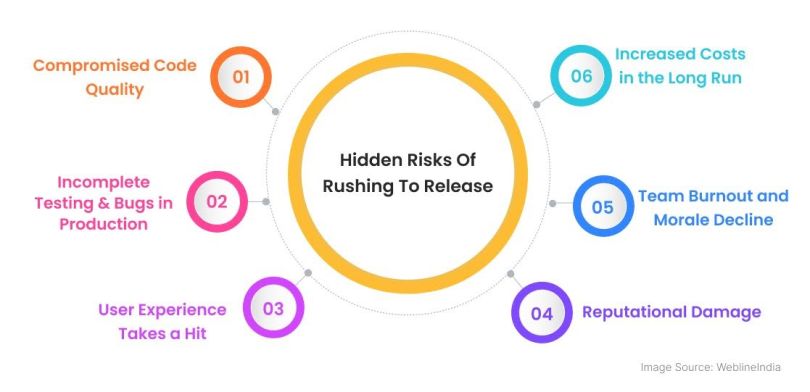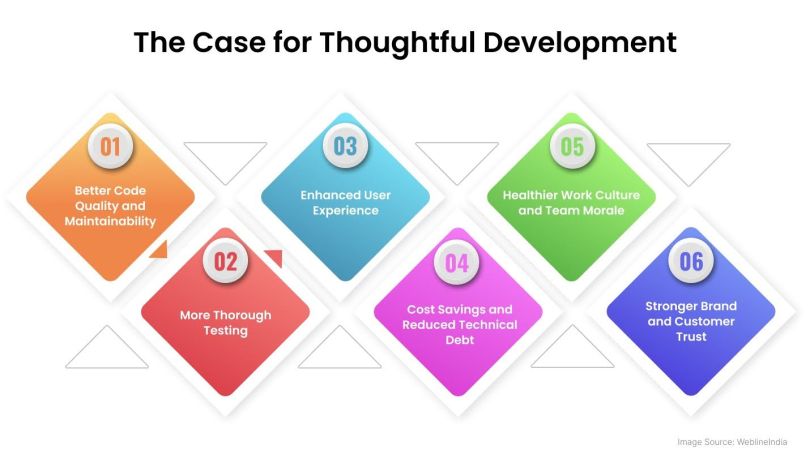There’s a never-ending urgency in the development industry to launch software products at record time, allowing businesses to take an edge over competitors, capture market share and respond to customer demands in no time.
While the idea of quick releases is appealing, it often leads to consequences that can outweigh any immediate benefits. Let’s explore the risks of rushing software releases and why you should prioritize thoughtful development over speed.
6 Benefits of Thoughtful Software Development
- You’ll have an easier time maintaining your code.
- There’s more time for testing before release.
- You’re able to create a smoother user experience.
- It reduces technical debt over time.
- Team morale is higher with fewer chances for burnout.
- You can earn customer trust and loyalty.
6 Risks of Rushing to Release Software
The urgency to release software quickly often comes at the cost of quality. Here are the top six complications of rushed software releases.

1. Compromised Code Quality
The rush to deliver software results in poorly structured, fragile and hard to maintain. Developers end up overlooking essential aspects like proper documentation, unit testing and code standards. They’re frequently forced to implement quick fixes that can break other parts of the software. This creates a growing technical debt, making it harder to scale or maintain the product in the future and affecting long-term sustainability.
2. Incomplete Testing and Bugs in Production
Testing is a key component of software quality, yet it’s one of the first elements sacrificed in the push for speed. Time constraints often result in limited unit testing, regression testing, performance assessments and security evaluations. Missing these steps can leave the software riddled with undetected defects, potentially exposing users to data loss, crashes or vulnerabilities. Bugs discovered in production can damage the user’s trust and be more expensive to fix once the software is live.
3. Worse User Experience
Poorly executed software that feels clunky, slow or frustrating is often a result of a rushed release. The user experience is one of those factors that requires careful design, thorough testing and iterative feedback from real users. In a hurry to launch, companies might skip critical UX refinements, leading to broken workflows, unintuitive interfaces and lagging performance. This ultimately alienates users, who may turn to alternative solutions that provide a smoother experience.
4. Increased Costs in the Long Run
While releasing software quickly may seem like a cost-saving strategy initially, the opposite is often true. Defects you find later in the development cycle, or worse, after release, are significantly more expensive to fix.
According to the “rule of 10,” the cost of fixing a bug increases tenfold as it progresses from one development phase to the next. A bug that you could have corrected during design might require substantial rework, system patches or even full redevelopment if discovered post-release.
5. Decline in Team Morale
The pressure to deliver at an accelerated pace can take a serious toll on software development teams. Prolonged periods of stress, long working hours and a constant expectation to respond to production issues lead to burnout and demotivation. Such environments are not sustainable for long-term productivity and can result in increased turnover rates and reduced morale, leaving a negative impact on both the team and the product.
6. Reputational Damage
Releasing software filled with bugs or offering a poor user experience can quickly damage a company’s reputation. A few negative reviews, social media backlash or coverage from tech bloggers highlighting flaws can tarnish the brand’s image. This can make potential customers wary of using the product and cause existing users to consider alternatives. Repairing reputational damage is challenging, and the cost of doing so is often far greater than taking extra time to ensure a quality release.
The Case for Thoughtful Development
Thoughtful development — ensuring that each phase, from design to testing, receives adequate time and attention — leads to much better outcomes. But it doesn’t stop there; software maintenance is necessary even after a successful release.
Regular updates, bug fixes and performance improvements are essential to ensure the software remains reliable, secure and efficient over time. Here are some key benefits of this approach.

1. Better Code Quality and Maintainability
When you give developers the necessary time to adhere to coding standards, implement best practices and properly document their code, the result is robust software that's easier to understand, maintain and expand. Code reviews, version control and continuous integration practices all play crucial roles in creating a stable, high-quality product and maintaining software quality assurance.
2. More Thorough Testing
A well-paced development process allows comprehensive testing at every stage. From unit testing to user acceptance testing, developers are able to test each feature thoroughly in isolated and integrated environments. This significantly reduces the chances of bugs in production and ensures that the software is reliable and stable before it reaches users.
3. Enhanced User Experience
Software that goes through iterative design cycles, with regular user feedback and refinements, will always result in a superior user experience. Thoughtful development makes sure the software is responsive, accessible and performs well. By investing time in user experience design, the final product will offer intuitive interfaces and smooth workflows, ultimately delighting users.
4. Lower Costs and Reduced Technical Debt
Addressing potential issues early in the development cycle minimizes the need for costly fixes and workarounds down the line. A thoughtfully developed product requires less rework and has fewer bugs, saving money and reducing technical debt over time. This leads to software that’s more efficient and cheaper to maintain.
5. Healthier Work Culture and Team Morale
Teams that work at a sustainable pace are more motivated and less stressed. When developers are given time to craft quality solutions and thoroughly test their work, they take pride in their contributions. A healthier work culture leads to higher team morale, greater productivity and reduced turnover, benefiting both the company and its software.
6. Stronger Brand and Customer Trust
Releasing high-quality, stable software fosters customer trust and builds a positive brand image. Users who have a good experience are more likely to recommend the product to others, leading to organic growth and a loyal customer base. A focus on quality over speed also distinguishes a company from competitors that might be pushing out less reliable software.
Taking the time to build software thoughtfully requires effort, patience and discipline. But building a strong foundation is crucial for software that will stand the test of time and deliver lasting success.





